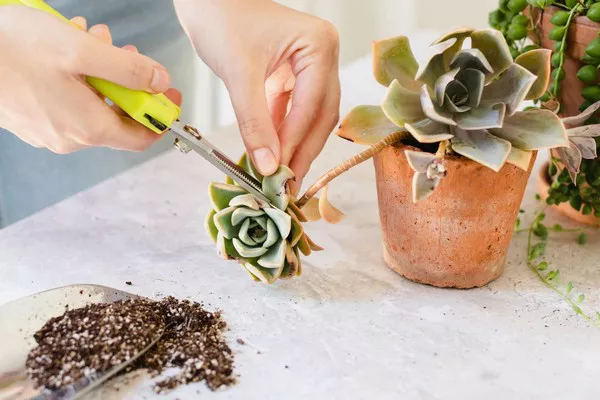Succulents, with their diverse shapes, colors, and sizes, have become popular choices for indoor and outdoor gardens. However, as the world of succulents encompasses a vast array of species and varieties, identifying the specific type of succulent you have can be a rewarding but sometimes challenging task.
Rosette-Forming Succulents
One of the most common and easily identifiable types of succulents is the rosette-forming variety. These succulents, including Echeverias, Sempervivums, and Aeoniums, are characterized by a circular arrangement of leaves that radiate from a central point, resembling a rosette. Echeverias, for example, have fleshy, spoon-shaped leaves forming tight, symmetrical rosettes. Sempervivums, commonly known as Hens and Chicks, produce rosettes that cluster and propagate at the base. Aeoniums, with their striking rosettes and often branching growth habit, add further diversity to this category of succulents.
Cacti and Cactus-Like Succulents
Cacti are a distinct group of succulents known for their unique features such as areoles (small, specialized structures from which spines, flowers, and new shoots emerge) and often spiny or prickly exteriors. While all cacti are succulents, not all succulents are cacti. Cacti belong to the family Cactaceae and include well-known varieties like the iconic Saguaro (Carnegiea gigantea) and the compact Barrel Cactus (Ferocactus). Some succulents, like certain Euphorbias, have evolved cactus-like features, making identification challenging without closer inspection. Look for the presence of spines, the arrangement of areoles, and the overall growth form to distinguish cacti from other succulents.
Trailing or Hanging Succulents
Trailing or hanging succulents are characterized by their cascading growth habit, making them ideal for hanging baskets or elevated planters. String of Pearls (Senecio rowleyanus), with its bead-like leaves, is a well-known example. String of Bananas (Senecio radicans) and Burro’s Tail (Sedum morganianum) are other popular trailing succulents. These plants are recognized by their long, cascading stems that can reach impressive lengths. When identifying trailing succulents, observe the arrangement of leaves along the stems, the shape of the leaves, and the overall growth pattern.
Succulents with Distinct Leaf Shapes
Many succulents are known for their unique and distinctive leaf shapes, contributing to their visual appeal. Aloe Vera, for instance, has long, tapered leaves with serrated edges, often forming a rosette. Agave species, on the other hand, are recognized for their thick, fleshy leaves with sharp spines at the tips. Haworthias, with their rosettes of pointed, often translucent leaves, add further diversity to this category. When identifying succulents based on leaf shapes, pay attention to the size, color, texture, and arrangement of the leaves, as these features can provide valuable clues.
Succulents with Colorful Foliage
The coloration of succulent leaves can vary widely, adding vibrancy and visual interest to your collection. Jade Plants (Crassula ovata), for example, typically have glossy green leaves, while certain varieties of Echeverias exhibit pastel hues ranging from pink and purple to blue and green. Some succulents, like the Red Pagoda (Crassula capitella) and Rainbow Elephant Bush (Portulacaria afra ‘Variegata’), showcase colorful variegation in their foliage. When identifying succulents based on color, consider the overall hue, the presence of patterns or variegation, and whether the color changes with factors like sunlight or temperature.
Compact or Miniature Succulents
Compact or miniature succulents are prized for their small size and often intricate forms. These succulents, including Miniature Aloe (Aloe ‘Lilliput’), Miniature Agave (Agave parviflora), and Tiny Titan (Haworthiopsis attenuata ‘Tiny Titan’), are ideal for small spaces, terrariums, or as accents in larger arrangements. When identifying compact succulents, observe the size of the plant, the arrangement of leaves, and any unique features that distinguish them from larger counterparts of the same species.
Unusual or Rare Succulents
For succulent enthusiasts, the world of rare and unusual succulents holds particular fascination. Crested or monstrose forms, such as the Crested Euphorbia lactea ‘Cristata’ or the Monstrose Aloe ‘Hercules,’ feature abnormal growth patterns that set them apart. Variegated varieties, like the Variegated String of Hearts (Ceropegia woodii ‘Variegata’), showcase unique color patterns. Identifying unusual or rare succulents often requires careful observation of their distinct features, growth habits, and any atypical characteristics that make them stand out.
Succulents with Unique Flowering Patterns
While many succulents are admired for their striking foliage, the diversity of flowering patterns adds another layer of beauty. Aloe species, for instance, produce tall, tubular flowers in various colors, often attracting pollinators. Echeverias send up flowering stalks with bell-shaped blooms in hues that complement their rosettes. When identifying succulents based on their flowers, consider the size, shape, and color of the blooms, as well as the overall structure of the flowering stalk.
Conclusion
Identifying the type of succulent plant you have can be an enjoyable journey of discovery, unlocking the unique characteristics that make each species or variety distinct. Whether you have rosette-forming Echeverias, trailing String of Pearls, or rare and unusual specimens, understanding the key features of your succulents is essential for providing optimal care and appreciation. Utilize resources such as plant identification guides, online communities, and botanical databases to further enhance your knowledge and confidently identify the diverse succulents that grace your collection. As you delve into the world of succulent identification, you’ll deepen your connection with these resilient and captivating plants.


